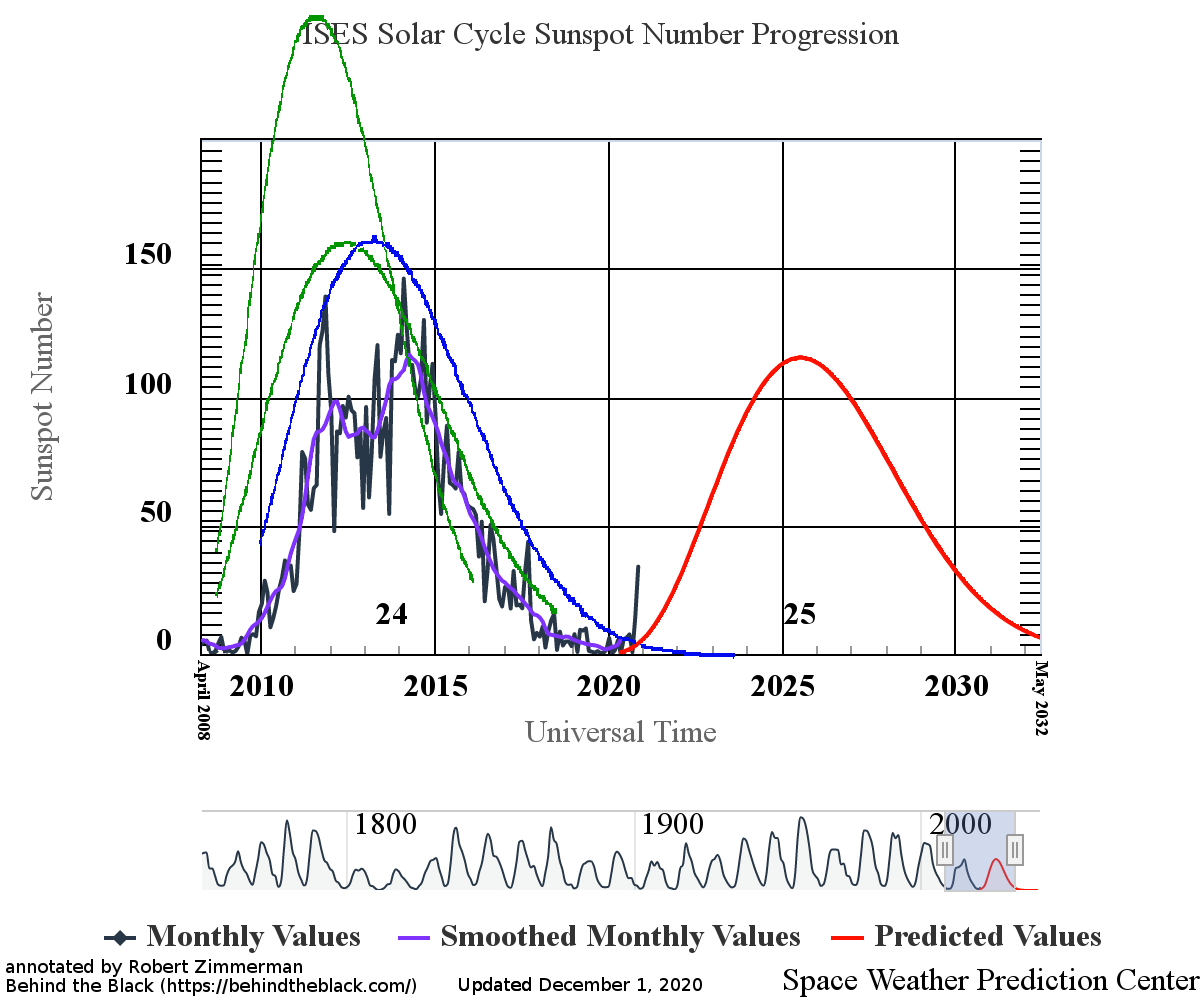Sunspot update: November most active sunspot month since 2017
My monthly sunspot for December is late this month because I simply forgot to do it. (Thanks to reader Phill Oltmann for prodding my memory.)
Below is NOAA’s monthly graph for tracking the Sun’s monthly sunspot activity, annotated by me to show the past solar cycle predictions.
The increasing sunspot activity we saw in October continued spectacularly in November. In fact, the amount of activity was the most seen since the summer of 2017, when the last solar maximum gave us its last big outburst.

The graph above has been modified to show the predictions of the solar science community for the previous solar maximum. The green curves show the community’s two original predictions from April 2007 for the previous maximum, with half the scientists predicting a very strong maximum and half predicting a weak one. The blue curve is their revised May 2009 prediction. The red curve is the new prediction, first posted by NOAA in April 2020.
November’s activity proves unequivocally that a new solar maximum is coming. We will have no grand minimum this cycle, despite the unprecedented knowledge it would bring us. The sudden increase in November is not unusual during the initial ramp up to solar maximum, but if a grand minimum was coming we would have likely not seen such a burst of activity.
November’s outburst demonstrates again that solar scientists still don’t understand the fundamental processes that cause the Sun’s magnetic dynamo to cycle as it does. In the past decade we have had predictions calling for either a decline in sunspots, a significant increase, or no significant change during this upcoming cycle.
While the middle prediction now appears more correct, it is still too soon to say. As I noted in 2019, “The range of predictions here is so great that essentially it shows that there really is no consensus on what will happen.”
On Christmas Eve 1968 three Americans became the first humans to visit another world. What they did to celebrate was unexpected and profound, and will be remembered throughout all human history. Genesis: the Story of Apollo 8, Robert Zimmerman's classic history of humanity's first journey to another world, tells that story, and it is now available as both an ebook and an audiobook, both with a foreword by Valerie Anders and a new introduction by Robert Zimmerman.
The print edition can be purchased at Amazon or from any other book seller. If you want an autographed copy the price is $60 for the hardback and $45 for the paperback, plus $8 shipping for each. Go here for purchasing details. The ebook is available everywhere for $5.99 (before discount) at amazon, or direct from my ebook publisher, ebookit. If you buy it from ebookit you don't support the big tech companies and the author gets a bigger cut much sooner.
The audiobook is also available at all these vendors, and is also free with a 30-day trial membership to Audible.
"Not simply about one mission, [Genesis] is also the history of America's quest for the moon... Zimmerman has done a masterful job of tying disparate events together into a solid account of one of America's greatest human triumphs."--San Antonio Express-News


Very interesting November data! There is little question that the early solar spotters would have seen this kind of uptick. The ones in question were the tinny transient sunspots we are now able to observe.
The upcoming months should give solar dynamicists data for a deluge in papers.